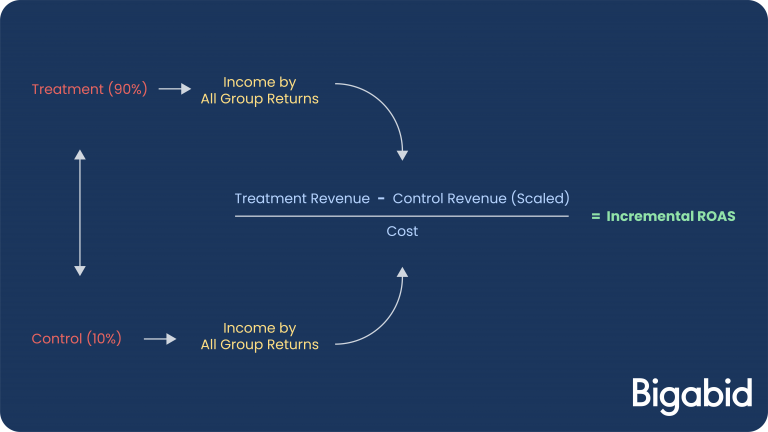By Yotam Golan and Eli Hagag
“Transparency is key to success in retargeting and especially when measuring incrementally. If your advanced retargeting partner can’t see anything about the user other than a list, identifier, and LTV, they can only be used as a “pipe” rather than your actual data partner.”
Incremental Value

By Yotam Golan and Eli Hagag
A new and necessary trend that has yet to be adopted by many digital advertising companies is the incrementality measurement of retargeting campaigns. Retargeting is crucial for your app’s growth. The essential way to measure “growth” is by understanding the added value it has on top of the organic or natural return of users to your app, especially high LTV users.
As a leader in mobile retargeting with transparency as our core value, Bigabid is dedicated to openly discussing this vital topic. This blog will cover incremental value, how you can apply it to retargeting activity, and the many challenges we face in ensuring its implementation.
What is Incrementality and How Should it be Measured?
Incrementality is a fancy name for a method that with basic operational guidelines actually makes a lot of common sense. Basically put, incrementality is the measure of the lift that advertising spend provides to the conversion rate. Incrementality allows the advertiser to measure the effect of paid advertising for users from being idle/churned to coming back to the app on top of the organic return.
In addition to measuring incrementally, the most common practice of isolating organic from paid advertising activity is by separating the users into control and treatment groups. We do that as follows:
Both groups must include users with the same characteristics, usually according to lifetime spend and the number of days idle.
The control group will only include users that will not interact with any type of paid advertising through any source.
The treatment group will include all users that will be targeted by the retargeting activity in question.
*It’s important to note that unless these groups are separated and isolated as mentioned above, the retargeting activity cannot be measured properly as the experiment will be “contaminated”.
Control and treatment groups can be separated at any ratio depending on the user base, app size, budget, activity goal, and advertiser’s goals, etc. We generally choose a smaller control group for being able to track uplift as we scale and a bigger group for learning the success of the campaign faster. The golden rule is that we cannot change the control group size during the campaign. This would blend users from both groups challenging the validity of the results and the growth potential of the activity, which may lead to a lower LTV overall. The most common split is 10% control and 90% treatment. In that case, we normalize the results to understand the incremental ROAS.
As you can see in the diagram below, after splitting the groups, we sum their income, reduce the scaled control income from the treatment, and then split by the total cost of the retargeting activity.

The final result gives us the incremental ROAS so we can better understand if and how to scale moving forward.
The importance of Isolating Segments
Incremental activities are highly dependent on the organizational and operational order behind them. Isolating control and treatment groups when beginning the retargeting activity is relatively easy. Maintaining incrementality when scaling and working with various partners is the real challenge.
Consider an app that spends $5,000,000 per month on user acquisition and retargeting with 500,000 users eligible for retargeting, 6 partners, and social media advertising platforms all working simultaneously on the same UA and RT activities. The bigger and the more active the retargeting client is, the bigger the challenge.
The way Facebook and other social media platforms differentiate user acquisition from retargeting is pretty confusing and leads to advertisers being misled that their activity is more successful than it really is. It’s necessary to divide social media channels from DSPs and especially Gen 2 DSPs.
Discover more about Generation 2 DSPs in The Modern Age of Mobile DSPs.
2nd generation DSPs keep it simple because they work similarly across different companies and completely separate user acquisition from retargeting activities, making everything easier to track. And if you consider the lack of transparency when retargeting through social media, a Gen 2 DSP’s approach not only helps measuring incrementally, but also informs the different teams on the advertiser side on how their internal KPIs and scaling roadmaps are doing.
Working with various partners is achievable and not as scary as it may seem from what we’ve noted. It requires the advertiser to be highly focused on choosing the right partners who separate groups correctly and follow the same principles as the retargeting activity scales. If these guidelines are in place from the beginning and enforced, retargeting is a highly profitable business for any mobile advertiser.
Discover more about The 4 Pillars for Successful Retargeting.
Finding the Right Partner for Retargeting
Finding the right partner for retargeting is as important or more than it is for user acquisition. Although retargeting is far from being adopted by the majority of the app market, it is extremely profitable. It can pump life into your app, accelerate your growth, and even contribute to your organic user acquisition and retargeting through ASO, social, owned media, and word of mouth.
Unlike user acquisition, where there are endless partners to choose from, retargeting is actually a much smaller market. Retargeting is an underestimated tool that requires sophisticated and capable teams. It involves deep linking, personalized creatives, and complicated analysis of user’s behavior using sophisticated data science and machine learning.
Many DSPs capable of user acquisition cannot run retargeting activities. Many claim they can, but cannot back it up with the tools, knowledge, and experience necessary to implement it with incremental value.
A most common phrase we hear in this regard is, “Here is a list of users to retarget, so what is the problem?”. If it were that easy, wouldn’t all advertising companies take advantage of it? The ideal partner should be able to look at your data and recommend what is best for you, who to retarget, how to split your segments, which creatives you should use, where to buy, and how much it will cost. And they should help you prepare the basic infrastructure for healthy scaling in the future. Look for a long-term partner and not for someone looking for a quick win.
Transparency is key to success in retargeting and especially when measuring incrementally. If your advanced retargeting partner can’t see anything about the user other than a list, identifier, and LTV, they can only be used as a “pipe” rather than your actual data partner.
Read more about Bigabid’s Partnering with Transparency approach.
Sharing data can be a big step, but it’s required for getting optimal results. It’s crucial to choose your partner wisely when sharing data. Always ask for privacy and data policy compliance, sign data privacy agreements, review their case studies, and ask your peers. Please click the “contact us” button below, as we look forward to demonstrating true incremental value in your retargeting activities.